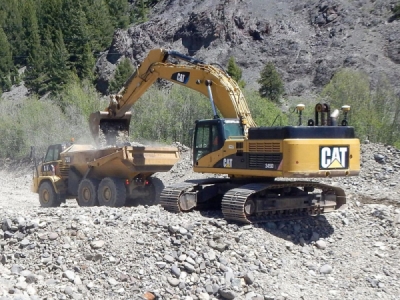
Posted on June 18, 2019
Project will repair damage done by gold dredging
A project begun last year to restore nearly a mile of the Yankee Fork River from the impacts of dredge mining has resumed and is planned to continue through the summer.
Among other benefits, the project will improve the ability of the Yankee Fork to support Chinook salmon, steelhead and bull trout, all of which are listed as threatened species under the Endangered Species Act.
The Yankee Fork is a tributary of the Salmon River about 12 miles downstream from Stanley. Between 1940 and 1952, a dredge mined about 6 miles of the river to collect gold. According to a press release from the Salmon-Challis National Forest, that eliminated side channels, streamside vegetation and floodplains and left large piles of rock, gravel and sand on the valley floor. The Forest Service stated that even though more than 60 years have passed since the dredging occurred, the Yankee Fork has been unable to revert back to a natural condition, and the ability of the area to support fish is still impaired.
The project began in 2018, and the main phases are expected to be complete by 2020. During 2018, work focused on removing about 100,000 cubic yards of tailings, stockpiling soil and reconstructing the parking lot across from the Yankee Fork dredge. Custer County crushed some of the tailings and used the material to resurface portions of the Yankee Fork Road and Custer Motorway. Project managers also used some of the tailings for upland restoration at the south end of the project.
During 2019, work will focus on removing the remaining surplus tailings and constructing stream channels and floodplains. Most of this work is expected to occur between June and September. During that time, crews and heavy equipment will be working on and around the project, including the Yankee Fork Road. Project managers do not anticipate any temporary road or campground closures or extended traffic delays. However, the project area will be closed to public access, including fishing, while work is occurring.
The project covers about 46 acres on the Salmon-Challis National Forest and on private land owned by the J.R. Simplot Co.
It is a joint effort between the Bureau of Reclamation, Bonneville Power Administration, Idaho Governor’s Office of Species Conservation, J.R. Simplot Co., NOAA Fisheries, Salmon-Challis National Forest, Shoshone-Bannock Tribes and Trout Unlimited.
“This project demonstrates the significant work that can be accomplished when people work together towards a common goal,” said Cassi Wood, project specialist for Trout Unlimited. “In this case, that goal is a healthier watershed and better fish habitat.”
About seven acres of tailings near the dredge are being left in place to help preserve the mining history of the area. Additionally, the project involves creating three new parking areas and reconstructing an existing parking area near the dredge.
The Bonanza Stream Restoration Project is the eighth restoration project implemented by the Yankee Fork Interdisciplinary Team.
For additional information on the project, contact Bart Gamett at 208-588-3420 or bart.gamett@usda.gov.
Source: mtexpress.com





